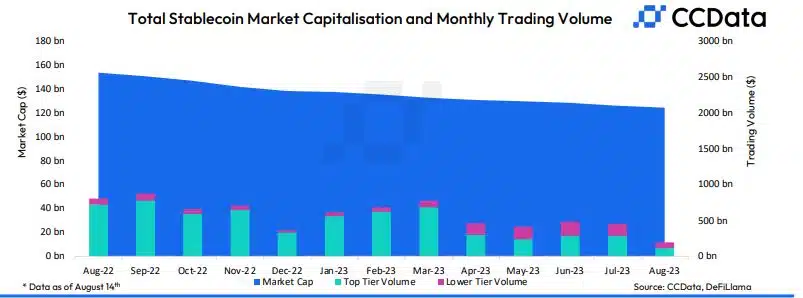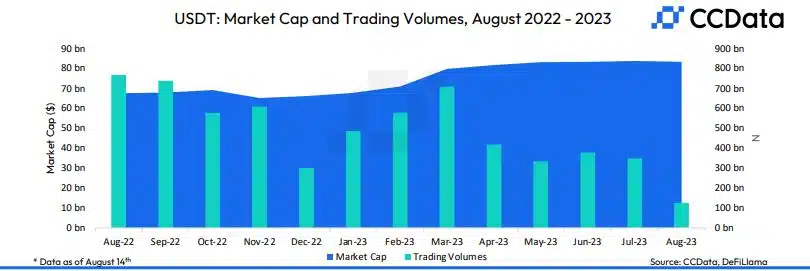Stablecoins stare at another disappointing month – why?

- USDT’s market cap dropped by 0.62% to $83.3 billion in August.
- The progress made by countries on CBDC posed another headache for stablecoins.
Stablecoins are the backbone of the digital asset market, and are widely seen as having the best possibility of mimicking or perhaps replacing traditional currencies. By combining the benefits of cryptocurrencies while maintaining a fixed value, these unique assets serve as the primary way for traders on non-fiat crypto exchanges to enter and exit trades.
However, ever since the sensational collapse of TerraUSD [UST] in 2022, the sentiment around stablecoins has become one of increased caution and scrutiny.
According to the latest report by digital assets market data provider CCData, the total stablecoin marketcap recorded the 17th straight month of downfall as of 14 August. The market cap fell to $124 billion, the lowest since August 2021.
As major cryptos like Bitcoin [BTC] witnessed historic lows in volatility, active trading declined considerably, leading to lower demand for stablecoins. As of 14 August, stablecoin trading volume was just $194 billion. At the prevailing rate, August was on track to record another dry spell, as per the report. Recall that July logged the second-lowest monthly stablecoin trading volume of the year at the time of publication.
USDT’s depeg unnerves market
Being the largest stablecoin, Tether [USDT] is considered as a bellwether for stablecoin sentiment in the market. As a result, headwinds affecting USDT usually have a rippling effect on the broader ecosystem.
USDT’s market cap dropped by 0.62% to $83.3 billion in August, marking the first loss in the end-of-month market cap since October 2022. The USD-pegged crypto had a tough time last week after it suffered the deepest depeg since the collapse of FTX exchange in 2022.
Due to the depeg, USDT witnessed a significant rise in redemptions. However, the issuing company Tether managed to process the redemptions with relative ease, instilling trust in USDT’s reserves.
Having said that, the incident had a far lesser impact on the stablecoin market cap when compared to some of the other crypto crises. At the time of writing, USDT almost regained its value, trading at $0.9987, per CoinMarketCap data.
Meanwhile, crisis-hit USD Coin [USDC] extended its losing streak. The second-largest stablecoin’s market cap declined for the eight consecutive months, falling 1.82% to $25.8 billion.
FDUSD’s ascent shakes up the dynamics
The report also drew attention to the emergence of another Binance-backed stablecoin First Digital USD [FDUSD].
After getting listed on the crypto behemoth in the last week of July, FDUSD’s market witnessed a whopping 1410% surge in August. The impressive growth catapulted the dollar-pegged asset to become the tenth-largest stablecoin in the market, with the valuation above $305 million.
The coin was listed as part of Binance’s popular zero fee trading program, which slashed maker and taker fees for practically all spot trading pairs.
Interestingly, FDUSD scooped a big portion of the market share from other Binance-related stablecoins. Binance USD [BUSD] and TrueUSD [TUSD] registered sizable declines of 9.35% and 9.15% to $3.37 billion and $2.75 billion, respectively, per the report.
Notably, BUSD was in a phasing-out stage. Binance has put its focus on promoting other stablecoins like TUSD and the recently-launched FDUSD.
PayPal’s stablecoin push
The month of August also saw big moves from the TradFi giants in the sphere of stablecoins. Online payments company PayPal debuted its stablecoin PayPal USD [PYUSD], in a bid to improve the payment experience in virtual environment.
The market cap of the Ethereum [ETH]-based stablecoin was just about $27 million as per the report. However, given the magnitude and size of PayPal’s ecosystem, the coin stood to gain significantly in the future.
To put things into perspective, even if PYUSD was used for 1% of PayPal’s payment volume in Q2 2023, the transaction volume would be almost $3.77 billion.
Stablecoins brace for CBDC threat
Most experts would agree that in today’s world, stablecoins would face the biggest challenge from Central bank digital currencies (CBDCs). Many emerging markets have been doubling down on their CBDC efforts lately.
As the name suggests, these assets will be issued by the country’s central bank. And each CBDC will be pegged to the national currency. The motive behind backing these assets is to extend the benefits of stable digital currencies without losing regulatory control over them.
Russia started its digital Ruble trials recently in the hopes of shielding its monetary system from Western sanctions. Furthermore, South Korea divulged more details about its upcoming CBDC pilot phase.









